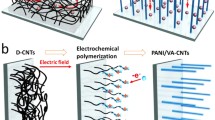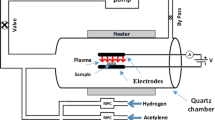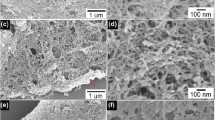Abstract
Vertically Aligned Carbon Nanotubes (VACNTs)-coated flexible aluminium (Al) foil is studied as an electrode for supercapacitor applications. VACNTs are grown on Al foil inside thermal Chemical Vapor Deposition (CVD) reactor. 20 nm thick layer of Fe is used as a catalyst while Ar, H2 and C2H2 are used as precursor gases. The effect of growth temperature on the structure of CNTs is studied by varying the temperature of CVD reactor from 550 °C to 625 °C. Better alignment of VACNTs arrays on Al foil is recorded at 600 °C growth temperature in comparison to other processing temperatures. Cyclic voltammetry results shows that VACNTs-coated Al foil has a specific capacitance of ~ 3.01 F/g at a scan rate of 50 mV/s. The direct growth of VACNT array results in better contact with Al foil and thus low ESR values observed in impedance spectroscopy analysis. This leads to a fast charge–discharge cycle as well as a very high value of power density (187.79 kW/kg) suitable for high power applications. Moreover, wettability study shows that the fabricated VACNT electrode has a contact angle of more than 152° which signifies that it is a superhydrophobic surface and hence shows lower specific capacitance in comparison to reported values for VACNT array. Therefore, it is necessary to develop suitable post-processing strategies to make VACNTs hydrophilic to realize their full potential in supercapacitor applications.







Similar content being viewed by others
References
Li L, Wu Z, Yuan S, Zhang X-B (2014) Advances and challenges for flexible energy storage and conversion devices and systems. Energy Environ Sci 7:2101. https://doi.org/10.1039/c4ee00318g
Ostfeld AE, Gaikwad AM, Khan Y, Arias AC (2016) High-performance flexible energy storage and harvesting system for wearable electronics. Sci Rep 6:4. https://doi.org/10.1038/srep26122
Chen T, Dai L (2014) Flexible supercapacitors based on carbon nanomaterials. J Mater Chem A 2:10756. https://doi.org/10.1039/c4ta00567h
Balamurugan J, Nguyen TT, Aravindan V, Kim NH, Lee SH, Lee JH (2019) All ternary metal selenide nanostructures for high energy flexible charge storage devices. Nano Energy 65:103999. https://doi.org/10.1016/j.nanoen.2019.103999
Ghai V, Baranwal A, Singh H, Agnihotri PK (2019) Design and fabrication of a multifunctional flexible absorber (Flexorb) in the UV–Vis–NIR wavelength range. Adv Mater Technol 1:1900513. https://doi.org/10.1002/admt.201900513
Li H, Tang Z, Liu Z, Zhi C (2019) Evaluating flexibility and wearability of flexible energy storage devices. Joule 3:613–619. https://doi.org/10.1016/j.joule.2019.01.013
Jin L, Wei K, Xia Y, Liu B, Zhang K, Gao H et al (2019) Tree leaves-derived three-dimensional porous networks as separators for graphene-based supercapacitors. Mater Today Energy 14:100348. https://doi.org/10.1016/j.mtener.2019.100348
Helseth LE (2019) Modelling supercapacitors using a dynamic equivalent circuit with a distribution of relaxation times. J Energy Storage 25:100912. https://doi.org/10.1016/j.est.2019.100912
Afif A, Rahman SM, Tasfiah Azad A, Zaini J, Islan MA, Azad AK (2019) Advanced materials and technologies for hybrid supercapacitors for energy storage – a review. J Energy Storage 25:100852. https://doi.org/10.1016/j.est.2019.100852
Li J, Qiao J, Lian K (2019) Hydroxide ion conducting polymer electrolytes and their applications in solid supercapacitors: a review. Energy Storage Mater. https://doi.org/10.1016/j.ensm.2019.08.012
Cossutta M, Vretenar V, Centeno TA, Kotrusz P, McKechnie J, Pickering SJ (2020) A comparative life cycle assessment of graphene and activated carbon in a supercapacitor application. J Cleaner Prod 242:118468. https://doi.org/10.1016/j.jclepro.2019.118468
Cao J, Mei Q, Wu R, Wang W (2019) Flower-like nickel–cobalt layered hydroxide nanostructures for super long-life asymmetrical supercapacitors. Electrochim Acta 321:134711. https://doi.org/10.1016/j.electacta.2019.134711
Winter M, Brodd RJ (2004) What are batteries, fuel cells, and supercapacitors? Chem Rev 104:4245
Zhu Z, Wang G, Sun M, Li X, Li C (2011) Fabrication and electrochemical characterization of polyaniline nanorods modified with sulfonated carbon nanotubes for supercapacitor applications. Electrochim Acta 56:1366–1372
Xu X, Li J, Li Y, Ni B, Liu X, Pan L (2018) Selection of Carbon Electrode Materials. In: Ahualli S, Delgado ÁV (eds) Interface Science and Technology. Elsevier, London
Lück J, Latz A (2018) Modeling of the electrochemical double layer and its impact on intercalation reactions. Phys Chem Chem Phys 20:27804–27821. https://doi.org/10.1039/C8CP05113E
Favaro M, Jeong B, Ross PN, Yano J, Hussain Z, Liu Z et al (2016) Unravelling the electrochemical double layer by direct probing of the solid/liquid interface. Nat Commun 7:1–8. https://doi.org/10.1038/ncomms12695
Chen T, Dai L (2013) Carbon nanomaterials for high-performance supercapacitors. Mater Today 16:272–280. https://doi.org/10.1016/j.mattod.2013.07.002
Wang Y, Zhang K, Zou J, Wang X, Sun L, Wang T et al (2017) Functionalized horizontally aligned CNT array and random CNT network for CO2 sensing. Carbon 117:263–270. https://doi.org/10.1016/j.carbon.2017.03.012
Lee CY, Tsai HM, Chuang HJ, Li SY, Lin P, Tseng TY (2005) Characteristics and electrochemical performance of supercapacitors with manganese oxide-carbon nanotube nanocomposite electrodes. J Electrochem Soc 152:A716–A720
Wang X, Lu X, Liu B, Chen D, Tong Y, Shen G (2014) Flexible energy-storage devices: design consideration and recent progress. Adv Mater 26:4763–4782. https://doi.org/10.1002/adma.201400910
Ghai V, Singh H, Agnihotri PK (2019) Dandelion-like carbon nanotubes for near perfect black surfaces. ACS Appl Nano Mater. https://doi.org/10.1021/acsanm.9b01950
Ghai V, Singh H, Agnihotri PK (2019) Near perfect thin film flexible broadband optical absorber with high thermal/electrical conductivity. J Appl Poly Sci 1:48855. https://doi.org/10.1002/app.48855
Ghai V, Bedi HS, Bhinder J, Chauhan A, Singh H, Agnihotri PK (2020) Catalytic-free growth of VACNTs for energy harvesting. Full Nano Carbon Nanostruct 1:6
Li WZ, Wen JG, Ren ZF (2002) Effect of temperature on growth and structure of carbon nanotubes by chemical vapor deposition. Appl Phys A Mater Sci Process 74:397–402. https://doi.org/10.1007/s003390201284
Xiang R, Luo G, Yang Z, Zhang Q, Qian W, Wei F (2007) Temperature effect on the substrate selectivity of carbon nanotube growth in floating chemical vapor deposition. Nanotechnology 18:415703. https://doi.org/10.1088/0957-4484/18/41/415703
Pham QN, Larkin LS, Lisboa CC, Saltonstall CB, Qiu L, Schuler JD et al (2017) Effect of growth temperature on the synthesis of carbon nanotube arrays and amorphous carbon for thermal applications. Physica Status Solidi (A) 214:1600852
Aksak M, Kir S, Selamet Y (2009) Effect of the growth temperature on carbon nanotubes grown by thermal chemical vapor deposition method. J Optoelectron Adv Mater 1:281–248
Yang Z-P, Ci L, Bur JA, Lin S-Y, Ajayan PM (2008) Experimental observation of an extremely dark material made by a low-density nanotube array. Nano Lett 8:446–451. https://doi.org/10.1021/nl072369t
Kyung SJ, Lee YH, Kim CW, Lee JH, Yeom GY (2006) Field emission properties of carbon nanotubessynthesized by capillary type atmospheric pressure plasmaenhanced chamical vapor deposition at low temperature. Carbon 44:1530–1534
Phokaratkul D, Mensing JP, Jaruwongrangsee K, Lomas T, Tuantranont A, Wisitsoraat A (2015) Novel 3D graphene foam Polyaniline Carbon nanotubes Supercapacitor Prepared by Electropolymerization. Proceedings of the 15th International Conference on Nanotechnology. IEEE, Rome
Dogru IB, Durukan MB, Turel O, Unalan HE (2016) Flexible supercapacitor electrodes with vertically aligned carbon nanotubes grown on aluminum foils. Prog Nat Sci Mater Internat 26:232–236. https://doi.org/10.1016/j.pnsc.2016.05.011
Mizuno K, Ishii J, Kishida H, Hayamizu Y, Yasuda S, Futaba DN et al (2009) A black body absorber from vertically aligned single-walled carbon nanotubes. Proc Natl Acad Sci 106:6044–6047. https://doi.org/10.1073/pnas.0900155106
Belhachemi Raël Davat (2000) A physical based model of power electric double-layer supercapacitors. IEEE Trans Indu Appl 1:3069–3076
Conway BE (1999) Electrochemical supercapacitors: scientific fundamentals and technological applications. Kluwer Academic/Plenum Publishers, BA
Kulal PM, Dubal DP, Lokhande CD, Fulari VJ (2011) Chemical synthesis of Fe2O3 thin films for supercapacitor application. J Alloy Compd 509:2567–2571. https://doi.org/10.1016/j.jallcom.2010.11.091
Aval LF, Ghoranneviss M, Pour GB (2018) High-performance supercapacitors based on the carbon nanotubes, graphene and graphite nanoparticles electrodes. Heliyon 4:e00862. https://doi.org/10.1016/j.heliyon.2018.e00862
Rose MF, Merryman SA (1996) Electrochemical capacitor technology for actuator applications. IEEE 1:245–250
Saghafi M, Mahboubi F, Mohajerzadeh S, Holze R (2014) Preparation of vertically aligned carbon nanotubes and their electrochemical performance in supercapacitors. Synth Met 195:252–259. https://doi.org/10.1016/j.synthmet.2014.06.012
Hsia B, Marschewski J, Wang S, In JB, Carraro C, Poulikakos D et al (2014) Highly flexible, all solid-state micro-supercapacitors from vertically aligned carbon nanotubes. Nanotechnology 25:055401. https://doi.org/10.1088/0957-4484/25/5/055401
Cui K, Wardle BL (2019) Breakdown of native oxide enables multifunctional, free-form carbon nanotube-metal hierarchical architectures. ACS Appl Mater Interface 11:35212–35220. https://doi.org/10.1021/acsami.9b08290
Taberna PL, Simon P, Fauverque JF (2003) Electrochemical characteristics and impedance spectroscopy studies of carbon-carbon supercapacitors. J Electrochem Soc 150:A292–A300
Raza W, Ali F, Raza N, Luo Y, Kim KH, Yang J, Kumar S, Mehmood A, Kwon EE (2018) Recent advancements in supercapacitor technology. Nano Energy 52:441–473
Dörfler S, Felhösi I, Marek T, Thieme S, Althues H, Nyikos L et al (2013) High power supercap electrodes based on vertical aligned carbon nanotubes on aluminum. J Power Sources 227:218–228. https://doi.org/10.1016/j.jpowsour.2012.11.068
Kavian R, Vicenzo A, Bestetti M (2011) Growth of carbon nanotubes on aluminium foil for supercapacitors electrodes. J Mater Sci 46:1487–1493. https://doi.org/10.1007/s10853-010-4950-1
Reit R, Nguyen J, Ready WJ (2013) Growth time performance dependence of vertically aligned carbon nanotube supercapacitors grown on aluminum substrates. Electrochim Acta 91:96–100. https://doi.org/10.1016/j.electacta.2012.12.058
Karumuri AK, He L, Mukhopadhyay SM (2015) Tuning the surface wettability of carbon nanotube carpets in multiscale hierarchical solids. Appl Surf Sci 327:122–130. https://doi.org/10.1016/j.apsusc.2014.10.154
Acknowledgement
Authors acknowledge the financial support provided by Department of Science and Technology (DST) India grant with sanction number CRG/2018/000265 to carry out this work.
Author information
Authors and Affiliations
Corresponding authors
Ethics declarations
Conflict of interest
The authors declare no competing financial interests.
Additional information
Publisher's Note
Springer Nature remains neutral with regard to jurisdictional claims in published maps and institutional affiliations.
Rights and permissions
About this article
Cite this article
Ghai, V., Chatterjee, K. & Agnihotri, P.K. Vertically aligned carbon nanotubes-coated aluminium foil as flexible supercapacitor electrode for high power applications. Carbon Lett. 31, 473–481 (2021). https://doi.org/10.1007/s42823-020-00176-4
Received:
Revised:
Accepted:
Published:
Issue Date:
DOI: https://doi.org/10.1007/s42823-020-00176-4




